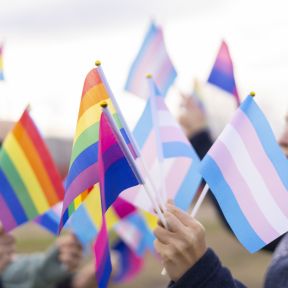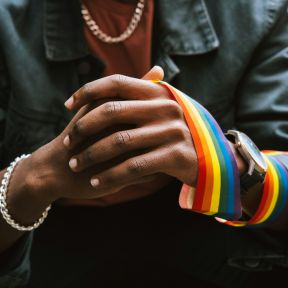
Sexual Orientation
Sexual orientation describes patterns of sexual, romantic, and emotional attraction—and one's sense of identity based on those attractions. Sexual orientation is distinct from gender identity, the internal sense of being male, female, or non-binary.
Contents

Heterosexuality (attraction to members of the opposite sex), homosexuality (attraction to members of the same sex), and bisexuality (attraction to members of both sexes) are the three most commonly discussed categories of sexual orientation, although they are by no means the only ones in the world of sexual identification.
The designation queer, for example, is used by some for its non-specificity to sexual orientation and gender identity, and acts as an umbrella term for non-heterosexual, cisgender individuals. Pansexual and omnisexual are terms gaining currency as the binary division of gender itself is called into question in some subcultures.
Sexual orientation describes patterns of sexual, romantic, and emotional attraction—and one's sense of identity based on those attractions. Some scientists categorize sexual orientation as being attracted to men or masculinity (androphilic), women or feminity (gynephilic), bisexual, asexual, or something else.
Sexual orientation refers to who individuals feel attracted to, while gender identity refers to one’s self-concept of being male, female, or non-binary. Developing a common vocabulary can help foster inclusive and productive discussions about sex and gender.
Sexual orientation is driven largely by biology, though the exact mechanism is unclear. Many sex characteristics in animals and in humans are determined in utero, too early to be affected by social and environmental factors. Male and female embryos are exposed to different hormones during development, which may influence sexual behavior.
Research indicates that men with older brothers are more likely to be gay. The so-called Fraternal Birth Order effect was identified in 1996 and has been replicated since. One hypothesis is that successive male pregnancies produce a maternal immune response that influences brain development. Another is that it could theoretically reduce sibling rivalry.
Estimates suggest that between 2 and 11 percent of people report experiencing same-sex attractions. However, the prevalence of people who experience same-sex feelings to at least some degree is likely to be much greater.
The number of American adults who reported having at least one same-sex partner in their lifetime doubled between the 1990s and 2000s. This dovetails with society becoming more accepting: In 1990, 13 percent of Americans believed that homosexuality was “not wrong at all.” By 2014, that jumped to 49 percent.
People who are asexual do not experience sexual attraction. Some asexual people experience romantic attraction, while others do not. There is a continuum of sexual attraction in the general population, but at what point along the continuum one becomes asexual is still under debate.

Disclosing one’s sexual identity—to parents, friends, employers, or partners—is a unique experience for each individual. Many emotions and questions can emerge during this process, as one comes to understand their own sexuality, share that information with loved ones, and forge new relationships. Coming out is a continuous process, and the LGBTQ individual should feel in control of the choices and conversations every step of the way.
Society has become much more accepting of the queer community, but some LGBTQ individuals may still experience internalized homophobia, which means internalizing society’s negative attitudes, stereotypes, and prejudice. Research shows that cultivating self-compassion—relating to oneself with understanding and kindness—is key to achieving self-acceptance, along with seeking out social support.
When an individual comes to understand and accept their identity, they may decide to disclose the information to those in their lives. Each unique disclosure, at each point in time, occurs after a process of awareness, assessment, and decision. Rather than a one-time event, it may be helpful to view coming out as a continuous process.
Many parents ultimately feel that the disclosure made them closer to their child as well as more open-minded and sensitive. But In the early stages, this five-step plan can help: confide in others, seek counseling if necessary, contact a support group, get educated, and let your child teach you.
Heterosexual parents of LGBTQ youth often feel unknowledgeable and concerned about providing accurate sexual health education. For example, they may wonder what advice to provide or whether to impose the same rules for different children. Becoming educated is the first step, and many online resources can help.

Being different can be an inherent source of stress, one that sexual minorities can experience acutely. Research shows that LGBTQ individuals suffer from anxiety, depression, substance use, and suicidality at higher rates than their heterosexual peers. These mental health challenges reveal how critical it is for individuals, clinicians, and society at large to examine how to address the challenges and needs of the queer community.
Sexual minority youth attempt suicide around five times more often than their heterosexual peers, and their attempts more often require medical treatment. Instances of abuse and harassment can contribute to suicide attempts. Supportive friends and family members, however, can help protect the mental health of sexual minorities.
Sexual minorities may be exposed to more risk factors for suicide than their heterosexual peers. Risk factors include childhood maltreatment, mental illness, chronic feelings of hopelessness, and the perceived sense of being a burden or not belonging. Risk factors specific to queer youth include gender nonconformity, low family support, and victimization. The combination can render sexual minority youth more vulnerable.
Therapists can learn to look at the field of psychology—including terms, definitions, and concepts—through the lens of queerness. This means stepping outside the framework of heteronormativity, the cultural assumption that heterosexuality is the norm and that everyone fits the gender binary, to respond in affirming ways to minority gender and sexual identities.














